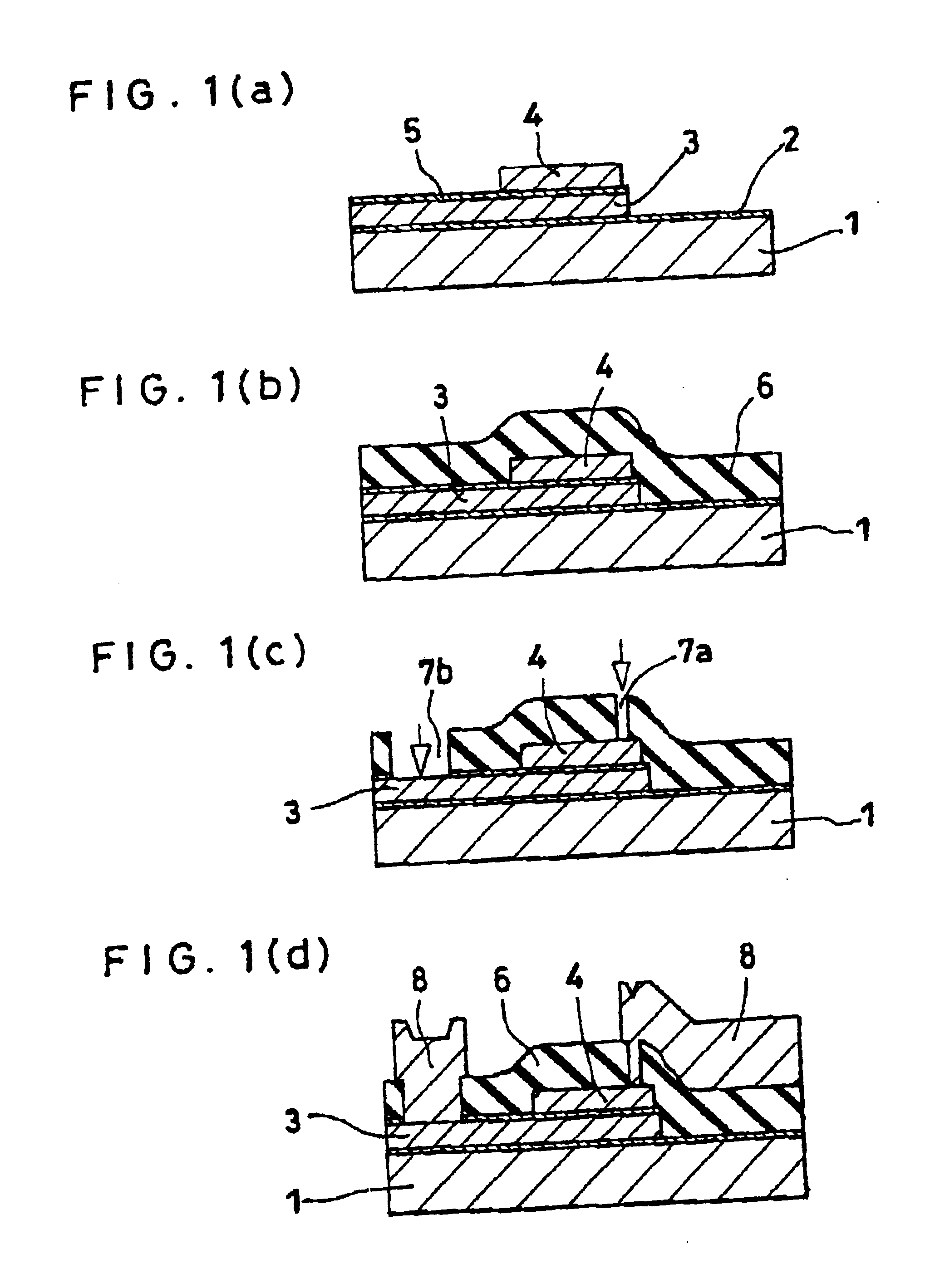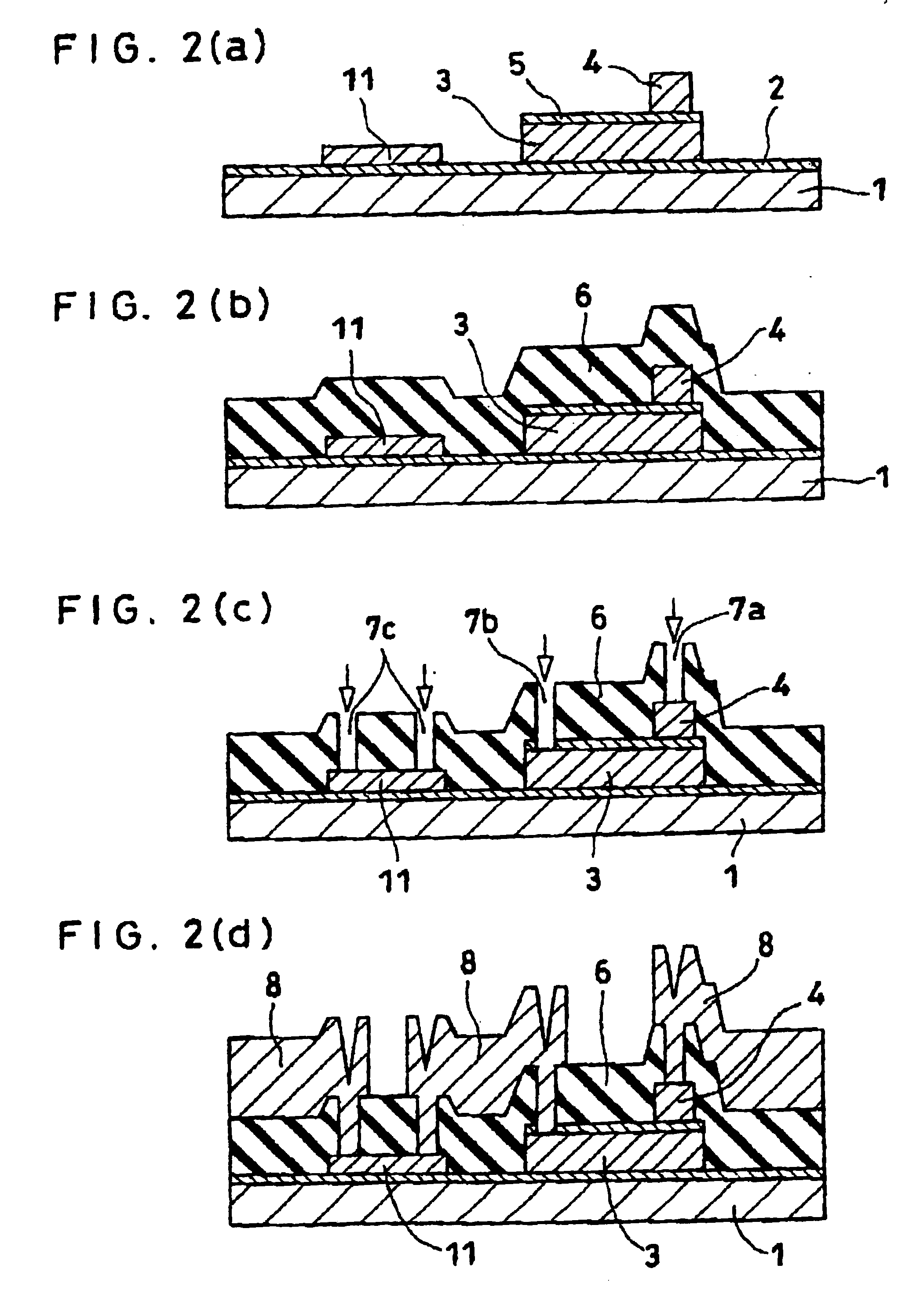Superconducting integrated circuit and method for fabrication thereof
a technology of integrated circuits and materials, applied in the direction of superconducting magnets/coils, superconductor devices, magnetic bodies, etc., can solve the problems of insufficient reliability of insulating films, high cost of vacuum equipment, and insufficient use of low-temperature-formed silicon oxide films and silicon nitride films as the materials for conventional insulating films, etc., to reduce the number of defective parts, reduce the number of steps of process, and simplify the method of production
- Summary
- Abstract
- Description
- Claims
- Application Information
AI Technical Summary
Benefits of technology
Problems solved by technology
Method used
Image
Examples
first embodiment
[0038]As this invention, the method for producing a superconducting tunnel device constituting a superconducting integrated circuit will be described below with reference to FIG. 1.
[0039]A protective layer 2 of MgO film against dry etching is formed on a substrate 1. A tunnel junction layer having a multilayer structure of Nb upper electrode 4 / AlOx tunnel barrier 5 / Nb lower electrode 3 is deposited thereon, then a resist pattern for the lower electrode and a twist pattern for the upper electrode are formed by the photolithographic technique. A tunnel junction layer is defined by dry etching through these resist patterns, as illustrated in FIG. 1(a).
[0040]Subsequently, a high-resolution, photosensitive, solvent-soluble, organic material, such as a photosensitive solvent-soluble block-copolyimide, is applied to the entire surface of the substrate 1 to give rise to an insulating film for insulating the upper and lower electrodes 4 and 3 from each other, as illustrated in FIG. 1(b). The...
second embodiment
[0048]FIG. 2 depicts an example of the formation of a superconducting integrated circuit inclusive of a superconducting tunnel junction and a resistor as this invention.
[0049]First, a protective layer 2, such as of MgO, against dry etching is deposited by the evaporation or sputtering technique on a substrate 1, then a Nb lower electrode 3, an AlOx tunnel barrier 5 and a Nb upper electrode 4 are continuously formed by the sputtering technique, the lower electrode 3 and the upper electrode 4 are defined by dry etching through a resist pattern for the lower electrode and a resist pattern for the upper electrode, further a Pd resistor layer is deposited by the evaporation technique through a resist pattern for the resistor, and thereafter a fine resistor 11 is formed by the lift-off technique, as illustrated in FIG. 2(a). Incidentally, during the course of the dry etching, the etching ceases proceeding at the surfaces of the tunnel barrier 5 and the protective layer 2.
[0050]Subsequentl...
third embodiment
[0054]FIG. 3 depicts a method for producing a superconducting integrated circuit inclusive of a ground plane, a wire-bonding pad, a superconducting tunnel junction and a resistor as this invention.
[0055]First, a protective layer 2, such as of MgO, against dry etching is deposited on a substrate 1 by the evaporation or sputtering technique and then a Nb ground plane 9 is formed thereon by the sputtering technique, as illustrated in FIG. 3(a). Further thereon, a SiO2 insulating interlayer layer 10 is formed as by the sputtering technique, a protective layer 2a against dry etching is deposited by the evaporation or sputtering technique, then a Nb lower electrode 3, an AlOx tunnel barrier 5 and a Nb upper electrode 4 are continuously formed by the sputtering technique, the lower electrode 4 and the upper electrode 5 are defined by dry etching respectively through a resist pattern for the lower electrode and a resist pattern for the upper electrode, further a Pd resistor layer is deposit...
PUM
 Login to View More
Login to View More Abstract
Description
Claims
Application Information
 Login to View More
Login to View More - R&D
- Intellectual Property
- Life Sciences
- Materials
- Tech Scout
- Unparalleled Data Quality
- Higher Quality Content
- 60% Fewer Hallucinations
Browse by: Latest US Patents, China's latest patents, Technical Efficacy Thesaurus, Application Domain, Technology Topic, Popular Technical Reports.
© 2025 PatSnap. All rights reserved.Legal|Privacy policy|Modern Slavery Act Transparency Statement|Sitemap|About US| Contact US: help@patsnap.com



